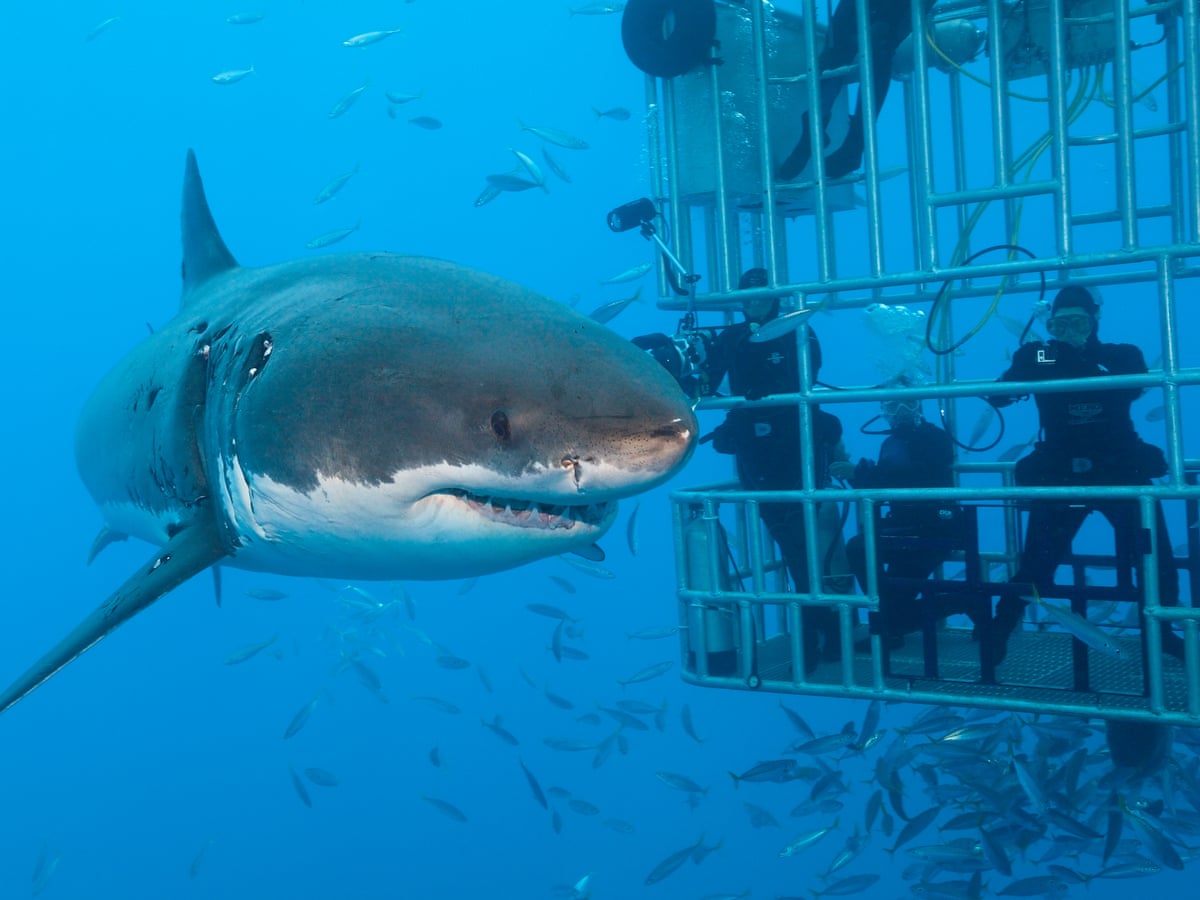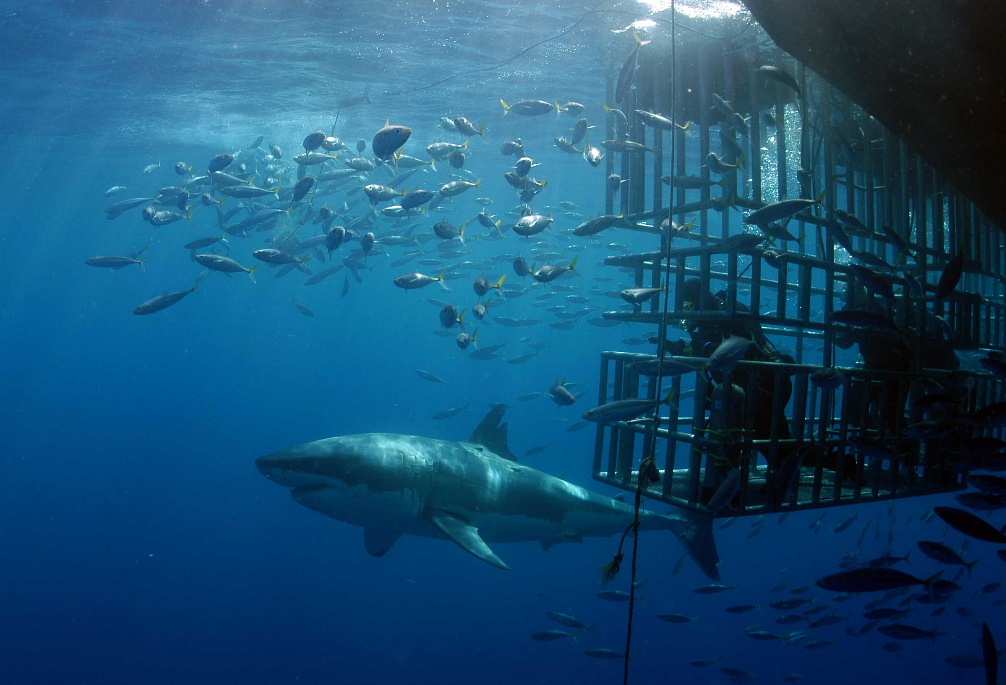
Shark cage diving is underwater diving or snorkeling where the observer remains inside a protective cage designed to prevent sharks from making contact with the divers. Shark cage diving is used for scientific observation, underwater cinematography, and as a tourist activity. Sharks may be attracted to the vicinity of the cage by the use of bait, in a procedure known as chumming, which has attracted some controversy as it is claimed to potentially alter the natural behaviour of sharks in the vicinity of swimmers.
Similar cages are also used purely as a protective measure for divers working in waters where potentially dangerous shark species are known to be present. In this application the shark-proof cage may be used as a refuge, or as a diving stage during descent and ascent, particularly during staged decompression where the divers may be vulnerable while constrained to a specific depth in mid-water for several minutes. In other applications a mobile cage may be carried by the diver while harvesting organisms such as abalone.
Popular Places For Cage Diving
1. False Bay/Seal Island, South Africa

Great white shark diving in South Africa is world famous. While the bottle-green waters of South Africa might not deliver the clearest visibility of the four shark-diving destinations, entering the cage and watching from the boat in False Bay is your best opportunity for seeing the animals pull an incredible “Air Jaws” maneuver — breaching fully out of the water in pursuit of a fur seal or the towed decoy. Seal Island, a short 25-minute boat ride from the mainland and less than an hour from Cape Town, teems with the great white’s favorite snack: The roughly 64,000 Cape fur seals here — in addition to the healthy cormorant and penguin colonies — can be equated to a dinner bell that never stops chiming. Divers spend time in the cage as well as observing breaching events topside from the boat, as the crew drags a decoy seal behind the wake in hopes of encouraging the sharks to pull power lunges out of the water.
When to Go: You can dive with the sharks at Seal Island from April to mid-September — outside those months they move inshore to feed on game fish and smaller sharks. Visiting between June and mid-August brings the best chance to see predation.
Operators: Apex Shark Expeditions runs small trips with no more than 12 guests and a maximum of two people at a time in the cage (breathing through snorkels).
2. Isla de Guadalupe, Mexico

For diving with great whites in crystal-clear water the color of peppermint mouthwash — allowing you to see the sharks approaching from very far away — there’s no place like Mexico’s Guadalupe Island. With sparse vegetation and curtains of fog that roll off it, this cragged, volcanic outcropping some 160 miles off the west coast of Baja is the perfect backdrop to great white encounters. A host of great whites patrols the waters here from summer to late fall.
You’ll take a shuttle south of San Diego to Ensenada, Mexico, where the liveaboard makes the 18-hour crossing to Guadalupe. Then it’s showtime. Cages are lowered off the boat’s stern and shark seekers scuttle across the bars to drop in, breathing air through a hookah attached to the surface and watching a scene straight from a documentary unfold as the sharks lunge at bait teased just out of reach by shark wranglers. The chance to descend to about 30 feet in a submersible cage gives you a different perspective on the surface cage action — call it a shark’s-eye view. And you can even venture outside the top of the cage, if you dare. It’s intimidating, but well worth doing for a literal bar-none view of the magnificent animals.
When to Go: August through October is peak season for seeing great whites off Guadalupe.
Operators: The Socorro Aggressor has three surface cages that take four guests and one submersible cage that takes four guests.
3. Farallon Islands, California
There’s something surreal about cruising under San Francisco’s iconic Golden Gate Bridge, seeing one of America’s great city skylines slink into its blanket of marine fog, and then heading 28 miles off the California coast in search of great whites. The Gulf of the Farallones National Marine Sanctuary is home to the largest seabird-breeding colony in the continental United States as well as a healthy population of elephant seals. It’s the latter animal, of course, that’s the lure for great whites. Some of the world’s largest great whites arrive at Southeast Farallon Island during the fall months to feast on the seals, which congregate to breed and calve their young. If you’re lucky enough to see a shark breach to attack a 200- to 300-pound elephant seal, it’s a memory that lingers a long, long time. Boats tow seal decoys on the surface of the water to attract the sharks — then it’s into the cage for a chance to see those jet-black eyes at a far closer range than most humans ever wittingly dare.
When to Go: Trips run from September through late November, when the elephant seals are in their greatest numbers.
Operators: Great White Adventures operates from the M/V Superfish, which accommodates up to 17 guests, with four people in the cage at a time.
4. Neptune Islands, South Australia

Australian Rodney Fox is credited with pioneering great white cage diving some four decades ago. And the operation he still runs — together with his son, Andrew — gives divers the best shot at seeing the healthy and hungry population of great whites of South Australia’s Neptune Islands. A marine reserve, the islands are home to the country’s largest colony of breeding New Zealand fur seals. During the Australian summer, big bulls arrive for the birth of their pups and to breed again, which naturally piques the sharks’ interest. Cage diving here during winter, however, is your best chance to see the enormous female great whites that can reach around 20 feet in length. Rodney Fox’s operation is the only one in the world to put a cage on the ocean floor (at between roughly 36 and 75 feet), offering a unique chance to see the sharks mingling with the area’s other denizens, including smooth rays, eagle rays and giant blue grouper. Scuba tanks are required in the bottom cage; the surface cages are for hookah breathers only.
When to Go: Trips take place during summer and winter, from the end of November to the end of February, and from late May until the end of October. (Late May is when the young- est seals enter the waters, learning to swim.) June, July and August offer the best chance to see the massive females.
Operators: Rodney Fox Shark Expeditions runs two- and three- night expeditions during summer, and four-night trips during winter months.